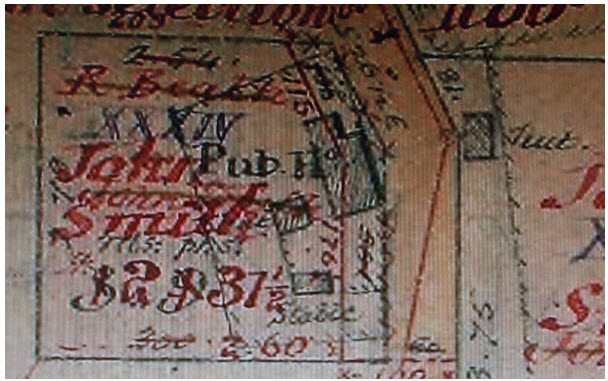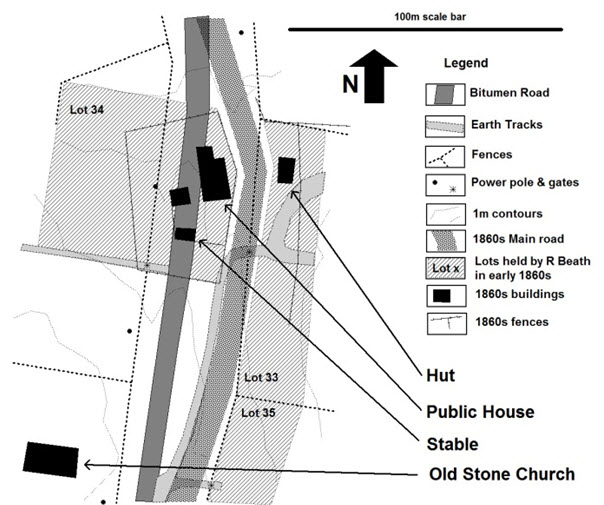Sources of information about the Prospect Inn
Records about the Prospect Inn span 22 yrs between 1852 and 1874, covering two of the most important periods of Wattle Flat’s gold mining history: the alluvial rush period 1852-1860 and the largely speculative reef-mining rush of 1872.
Newspaper records report in 1854, that there were then 3 public houses in Wattle Flat, with 3 or 4 others being constructed. Among the other very early public houses at Wattle Flat were the Greenman Inn, and the Junction Inn.
No clear maps & photographs of the Prospect Inn have been found, but an 1864 Crown Plan (CP400-1496) strongly links the late 1850’s publican & owner of the Prospect Inn (Robert Samuel Beath) with a substantial “Public House. On the old plan the Lot owners name for Lots 33, 34 & 35 are indicated in red ink to be John Smith. In the background the crossed-out name R. Beath can clearly be seen. On Lot 34 (XXXIV) the shape of a large Public House is clearly represented. Correlation of the historic & modern maps reveals that the former location of the Prospect Inn lies in the middle of the main road about 100m NE of the old stone church at the northern end of Wattle Flat village. i

Detail from an 1864 crown plan CP400-1496. Note the crossed out name “R Beath” and the new name John Smith.

Map showing the location of what is believed to be the Beath’s Prospect Inn in the context of today’s infrastructure.
History of the Prospect Inn
1850’s
During 1854 & 1855 the publican is recorded as S Jagoe, and Robert Beath is the owner. The Inn would have been constructed in 1852/1853, but no records have been found that document who built it.
In January 1854, a newspaper advertisement for the sale of the Prospect Inn includes the following description. “The tavern comprises a most capricious bar, 2 sitting rooms, and 5 bedrooms. There is a large kitchen, butcher’s shop’ stable, blacksmith’s shop and tools, stockyard and schoolhouse adjoining the premises.”
In September 1854 a magisterial inquiry is held at “Beath’s Prospect Inn” into the death of a woman from exposure to cold weather & immersion in a waterhole overnight.
In August 1855 a follow up advertisement in the Empire newspaper, for the sale of the Prospect Inn contains the following. “This house is remarkable for having, since it opened about 3 years ago, the best and steadiest trade of any in the district. The house is large and roomy, and has every accommodation for travellers. There is a four-stalled stable, piggery, garden and a yard 100 feet by 56, all fenced in with a substantial two railed fence and paling. There is also a three railed five acre paddock for the accommodation of teamsters, in the centre of which there are two large reservoirs, which afford a constant supply of water all the year round. Any person with a little capital should not let this opportunity pass, as it is a sure road to a small fortune. The Proprietor would not sell but is about going down the country.”
It seems that no one is prepared to buy this hotel at this time, and the Beath’s plan of travelling is thwarted.
On the same page of this August 1855 issue of the Empire another advertisement is for the sale of a Puddling machine in a most central position on the Wattle Flat. Respondents are to apply to Samuel Jagoe at the Prospect Inn.
During the years 1856-1860 Robert Beath is the licenced publican of the Prospect Inn, and the Beath’s are highly respected members of the Wattle Flat community.
In July 1857, Mr & Mrs Robert & Margaret Beath notify in the newspaper the birth of their daughter. This would be Margaret their 7th child.
1860’s
In 1861, Mr Robert Beath is the Treasurer & Secretary of the Wattle Flat Races Committee. An advertisement for these races in the “Bathurst Free Press & Mining Journal (BFPMJ)” includes the following. “2nd Race – The DIGGERS PURSE of 10 sovereigns for all horses that have never won a prize exceeding 5 sovs; the horses to belong to bona fide diggers residing within 3 miles of the Prospect Inn; weight for age; heats once round the course and a distance; 4 entrances or no race; qualification 10 per cent, entrance 10 per cent.”
From 1861 to 1865, little is known about this pub, partly because few copies of the BFPMJ have survived for this period. These years were fairly depressed, with only a scattering of miners on the field. It seems that the Beath family may have hung on for a while.
In 1865 the government introduces new systematic procedures & regulations regarding land ownership.
In 1865 John Smith a gold miner, makes application for Lots 33,34 & 35 ( parish of Sofala) which must include “Beath’s Prospectors Inn” (Lot 34). It seems that during John Smiths ownership of these 3 Lots, that a Thomas Smedly Pidding, store proprietor takes on the publicans licence for the Prospect Inn.
In 1868 John Smith dies, and ownership of the 3 lots & presumably the Prospect Inn becomes transferred (by transmission) to John Smith’s aunt Ellen Flynn licenced publican of the Miners Inn / Sofala Inn, Sofala.
1870’s
In 1869 Thomas Pidding becomes publican of the new Star Hotel at the Junction of Limekilns Road, Wattle Flat. Unfortunately Thomas Smedley Pidding becomes insolvent in 1870, just before the boom year of 1872 ahead.
In 1869 under Ellen Flynn’s ownership of the Prospect Inn, a young man Daniel McCarthy becomes the licenced publican of the Prospectors Inn, which he holds for the next five years
Daniel from Sydney married Mary Ann Murphy from Kelso, in Wattle Flat in 1863. Four girls & one boy are born to this young family while they run this hotel between 1869-1875. This was one of the most exciting periods in Wattle Flat’s history as it covers the peak gold rush year of 1872, when dozens of companies were formed to work the reefs at Wattle Flat, and city people came here in droves.
A Journalists description of the Prospect Inn in Oct 1872 reads “We next come to the Prospect Inn, kept by Mr. McCarthy. This is, I believe, the oldest established hotel in the township, and is certainly one of the most centrally and best situated in the township for men of business. The structure is of wood, and contains a spacious bar and assembly-room, three sitting, rooms, and twenty beds. There is also stabling for twelve horses. The creature comforts are well looked after, and there is nothing left undone by the worthy landlady, Mrs. McCarthy, to make her guests comfortable”.
Sadly, after all this, Daniel dies aged only 35 in 1875, the same year that his fifth child is born.
It is not known what happens to this pub after this.
Over the successive years it seems that this Public House was in the way of the main road. The present-day bitumen road passes over the site of the Inn. It is interesting to note that even in the 1864 map (above) the front of the Inn seems to be truncated by a line signifying widening of the main road.
Historical research & drafting by C Green, Wattle Flat Aug 2017.